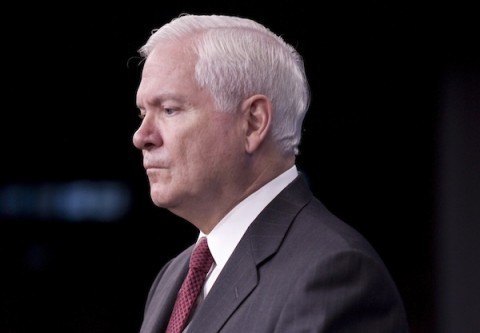Making Sense of Gates’ Iran Memo
The defense secretary did not indicate a higher likelihood of war, which would threaten Obama’s consensus-building approach.
Jul 31, 2020308 Shares308.4K Views
Secretary of Defense Robert Gates (EPA/ZUMApress.com)
The New York Times reportedon a memo written by Secretary of Defense Robert Gates in January about a paucity of U.S. policy options toward Iran if it continued with illicit uranium enrichment but stopped short of possessing a bomb. It’s a real problem — the proliferation equivalent of a bank robber pointing to the bulge in his pocket. (Does he have a gun or not?) By not declaring itself a nuclear power, something Obama administration officials say won’t happen for at least a year*, Iran won’t have opted out of the Nuclear Nonproliferation Treaty, but it will have increased its deterrent force by keeping its adversaries guessing about its actual nuclear capability. Gates’ memo asked if the U.S. was ready for that situation.
[Security1] Whether it was or wasn’t then, it’s pretty easy to see administration policy sincethen inclining to answer Gates’ question. It’s looking more and more like President Obama — who was so roundly vilified for deigning to propose, let alone pursue, a year’s worth of diplomatic outreach to the Iranian leadership — will be the one who shepherds an economic sanctions package on the Iranian regime’s key organs through the United Nations Security Council. After winning China’s acquiescence; spending almost a year and a half rebuilding relations with Russia; and leveraging new and less patient leadership at the International Atomic Energy Agency, the administration has pieces in position to unite the international community against Iran’s uranium enrichment. Even Obama’s chief Iran critic, his 2008 presidential rival Sen. John McCain (R-Ariz.), had to concedeWednesday, “I never thought a policy of engagement with Iran’s rulers would succeed, but I understand why the president pursued it.”
Beyond Iran, however, is the general problem of a hostile power nearing nuclear breakout capacity, something Gates’ memo correctly identifies as yielding unclear sanction under the NPT. Maybe that’s why next month, the signatories of the NPT will gather in New York to strengthen its provisions. And according to administration officials, one of the areas the U.S. wants to focus on is creating new rules for when signatories face greater penalties for drifting into noncompliance, perhaps through increased verification authorities and responsibilities for the IAEA — something last week’s nuclear security summit in Washington didn’t really substantively address — allowing the international community to have earlier warning into prospective breakout capabilities. The penalties that would come into force in such a case remain to be proposed, debated and accepted or rejected, of course. But the whole discussion speaks to the lacunae that Gates frets over in his memo.
What should be clear is that the memo doesn’t propose going to war, nor does it make war more likely. Administration officials have never ruled out any option on Iran. But they have leaned, at every step, on measures that attract wide international support and deny that support to Iran — from diplomatic outreach; to intensifying diplomacy when word of the Qom reactor leaked; to the proposal for enriching Iran’s uranium to a bomb-incapable state in a third country; to, as the result of the first three, economic sanctions. The administration shows no sign of changing that fundamental strategy.
Seen from that perspective, the prospect of military action, ahead of a push to sanction Iran at the U.N., would place that strategy at risk. The coalition Obama has stitched together might fray if other countries view the sanctions maneuver as a pretext for military strikes. Hence Gates’ own clarifying statement:
“„The New York Times sources who revealed my January memo to the National Security Advisor mischaracterized its purpose and content. With the Administration’s pivot to a pressure track on Iran earlier this year, the memo identified next steps in our defense planning process where further interagency discussion and policy decisions would be needed in the months and weeks ahead. The memo was not intended as a “wake up call” or received as such by the President’s national security team. Rather, it presented a number of questions and proposals intended to contribute to an orderly and timely decision making process. There should be no confusion by our allies and adversaries that the United States is properly and energetically focused on this question and prepared to act across a broad range of contingencies in support of our interests.
**Clarification, 9:28 a.m.*: The National Iranian-American Council takes issuewith my “at least a year” formulation about Iranian nuclear capabilities. Gen. David Petraeus, as far as I’m aware, first gave that back-of-the-envelope assessment to the Senate Armed Services Committee last month. And while other administration officials have given further-out assessments of that capability, I leaned on that one for two reasons: first, because all of them, by definition, agree we’re not going to see an Iranian capability for a nuclear weapon this year; and second, because even factoring in that pessimistic assessment, those officials still argue that we don’t have to move to a more bellicose posture from a policy perspective. But NIAC is right, of course, that Gen. James Cartwright, the vice-chairman of the Joint Chiefs of Staff, put the time frame between two and five years; and Cartwright used to oversee our nuclear weapons.

Hajra Shannon
Reviewer
Latest Articles
Popular Articles
